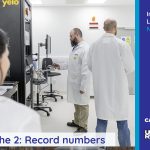“Digital design tool equals less brain activation” – RiR Mark Goudswaard reveals Digital Catapult project findings

Bristol University’s Mark Goudswaard checks in as his Researcher in Residence project on digital design tools with the Digital Catapult ramps up
Hi Mark, your project focuses on the creation of a Physical Digital Affordance Index (PDAI) – in theory how would this work in layman’s terms?
In layman’s terms, the PDAI would work as guide to support a designer in choosing whether to undertake a design activity physically or digitally. It would allow them to answer the general question – given I need to find out X with the involvement of stakeholders Y and Z, would a physical or digital design approach and/or representation be the most appropriate?
Why do you think this tool or area of research is important?
The whole world is going digital. This was true before Covid, but has been greatly accelerated by the global pandemic. There’s no question that digital tools are powerful and allow rapid design space exploration, but they aren’t real; they are abstractions of reality underpinned by a whole host of assumptions. It is important that they are used appropriately in combination with physical counterparts to ensure that design is carried out effectively and digital delusions are avoided! The PDAI will supper designers in making decisions that can support this.
“It’s exciting to be able to work with the Digital Catapult in this project as their wide experience in the digital space along with a broad portfolio of projects enables the creation of a physical-digital affordance index that can be industrially applied and used to improve design practice.”
You’ve started at Digital Catapult, are you any closer to creating the PDAI and achieving your objectives?
Yes, we’ve completed a first user study [results detailed below] and have been scoping application projects with the catapult for applying the PDAI.
Do you have any mid-point/early highlights of the project?
In the first phase of the project we were able to undertake a neuro-cognition study (where we measure brain activation) during design activities. These showed that the use of physical design tools yielded higher brain activation overall that their digital counterparts. This is interesting in itself but is more so when we consider that with physical tools, designers were able to complete the task quicker with less stress or frustration whilst making comparable outputs. In other words in the context of the study: Digital tool = less brain activation, more stress and more time to complete task for a similar design output.
How has the experience of working at the Digital Catapult been for you?
Working with the Digital Catapult has been a really positive experience and I have found them very receptive to the research we are and have been undertaking at the University of Bristol. As an early career researcher it’s the first time I have worked trying to apply my work outside of academic contexts and the Digital Catapult have provided a fantastic and welcoming environment for me to do this.



